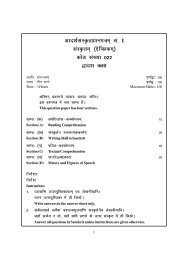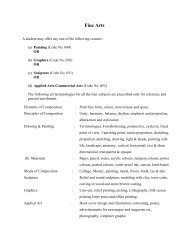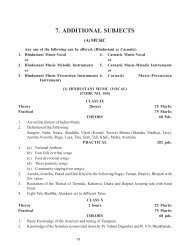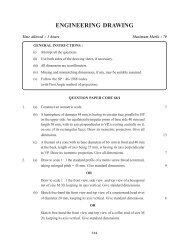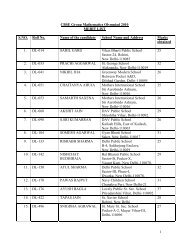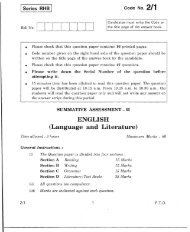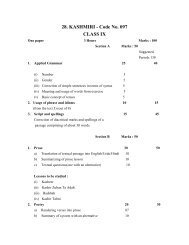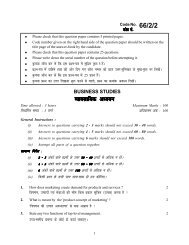A Text Book on Engineering Graphics - Central Board of Secondary ...
A Text Book on Engineering Graphics - Central Board of Secondary ...
A Text Book on Engineering Graphics - Central Board of Secondary ...
Create successful ePaper yourself
Turn your PDF publications into a flip-book with our unique Google optimized e-Paper software.
MACHINE DRAWING<br />
Soluti<strong>on</strong> :<br />
Steps Involved :<br />
Exercises :<br />
Refer Fig. 2.25<br />
(i) Start with the top view. Describe three circles <strong>of</strong> diameter d = 25mm, 0.8d =<br />
20mm, 1.5d = 37.5mm respectively. (Ød circle is broken to represent the internal<br />
thread <strong>of</strong> the nut.)<br />
(ii) Circumscribe square around the chamfering circle as shown in Fig 2.25<br />
(iii) Project the Top View to draw the Fr<strong>on</strong>t View<br />
(iv) Complete the Fr<strong>on</strong>t View as shown in Fig. 2.25.<br />
NOTE: that when two faces <strong>of</strong> square nut are seen in fr<strong>on</strong>t view, the corners are<br />
chamfered.<br />
ADDITIONAL INFORMATION<br />
The hexag<strong>on</strong>al nut takes preference over the other nuts. A spanner is used to turn<br />
the nut <strong>on</strong> or <strong>of</strong>f the bolt. The jaws <strong>of</strong> the spanner come across the opposite flats <strong>of</strong><br />
the nut. The angle through which the spanner will have to be turned to get another<br />
hold is <strong>on</strong>ly 60 in case <strong>of</strong> a hexag<strong>on</strong>al nut but 90° for a square nut. Though the angle<br />
is 45 in case <strong>of</strong> the octag<strong>on</strong>al nut, it is rarely used due to its complicated process <strong>of</strong><br />
c<strong>on</strong>structi<strong>on</strong>. So, it is more c<strong>on</strong>venient to screw <strong>on</strong> a hexag<strong>on</strong>al nut than a square<br />
nut in a limited space for turning the spanner.<br />
NOTE : Assume missing dimensi<strong>on</strong>s proporti<strong>on</strong>ately<br />
1. Draw to scale 1:1, the fr<strong>on</strong>t elevati<strong>on</strong> and plan <strong>of</strong> a hexag<strong>on</strong>al nut keeping axis<br />
vertical, when two <strong>of</strong> the opposite sides <strong>of</strong> the hexag<strong>on</strong> are parallel to V.P. Give<br />
standard dimensi<strong>on</strong>s.<br />
2. Draw to scale 1:1, the Plan and Fr<strong>on</strong>t View <strong>of</strong> a hexag<strong>on</strong>al nut, taking nominal<br />
diameter <strong>of</strong> the bolt = 30mm, keeping the axis perpendicular to H.P and two<br />
opposite sides <strong>of</strong> the hexag<strong>on</strong> perpendicular to V.P. Give standard dimensi<strong>on</strong>s.<br />
3. Draw to scale 1:1, the Fr<strong>on</strong>t View and Plan <strong>of</strong> square nut, taking nominal diameter<br />
= 30mm, keeping the axis perpendicular to H.P and two opposite sides <strong>of</strong> the<br />
square parallel to V.P. Give standard dimensi<strong>on</strong>s.<br />
4. Draw to scale 1:1, the Fr<strong>on</strong>t View and Top View <strong>of</strong> a square nut, taking nominal<br />
diameter =30mm, keeping the axis perpendicular to H.P and two opposite sides <strong>of</strong><br />
the square perpendicular to V.P. Give standard dimensi<strong>on</strong>s.<br />
ENGINEERING GRAPHICS 63



